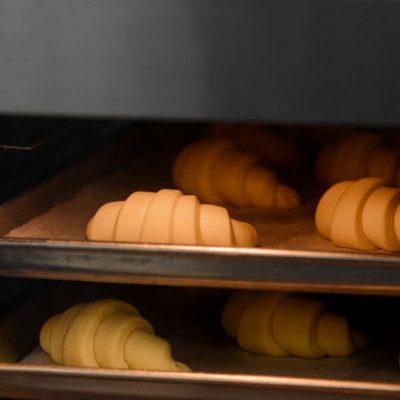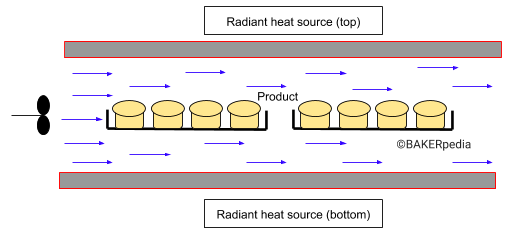
对流恒温烤箱
什么是对流烤箱?
A convection oven uses fans to circulate hot air around the product placed on racks in the baking chamber. This is the convective component of heat transfer. Convection ovens are perfect for baking small-sized goods such as pastry and other products that are baked free-standing on sheet pans or perforated racks.
对流传热与自然对流不同:1
- Instead of using fans, heat is transferred from air to the product.
- Temperature differences between air and product create a density gradient.
- As a result, there’s a vertical movement of air. The less dense hot air rises on top of colder air.
它是如何工作的?
对流烤箱中的加热产物是通过以下传热机制的组合完成的:2,3
- 来自电阻,蒸气或热气管,气体燃烧燃烧器火焰等热源的辐射。这很容易为空气和产品提供热量。
- 热空气强迫对流,风扇产生了气流。对流是主要的传热机制。
- Conduction from hot surfaces in direct contact with the product (e.g. racks or pans).
Convection ovens rely heavily on convection air currents and less on radiant heat sources. Therefore, the convective flow of air enhancesthe drying component of baking。这可以从面团/面糊的表面清除细水层,充当屏障(绝缘),以进行热渗透。
面团水分通常在对流烤箱中蒸发更快。结果,该产品比常规烤箱更快,更均匀地烘烤。这减少了总烘焙时间。
常规烤箱与对流烤箱
常规烤箱,热量升至顶部。因此,放置在顶部机架上的物品比放置在底部的物品要快得多。在对流单元中,热空气周围旋转。因此,在从常规烤箱切换到对流烤箱时,需要调整烤箱设置。
例如,为了在恒定的烘烤时间保持等效的烘焙处理,应降低25–50°F(14–28°C)。如果没有进行烤箱温度的调整,则应相应地减少烘烤时间以获得等效的烘焙处理。通常,它少20%。4

应用
In convection ovens, hot air is circulated by a fan at anair flow/velocity2–22 mph(1-10 m/s)。必须根据产品和烘焙条件仔细设定此速率。在烘烤过程中开发的对流传热系数(H)取决于烘焙室内的空气速度和温度。它的范围从20-120 w/m2 K.4
快速气流会扭曲细腻产品的形状,例如海绵蛋糕,面糊和柔软的面团,例如糕点。他们还可以将产品干燥,从而对其质地,保质期和overall quality。面团碎片的快速表面干燥可能会形成坚硬的皮肤,可以防止在烤箱弹簧期间面团膨胀。另一方面,太慢的气流可以降低传热速度并增加烘烤时间。这阻碍了对流。
理想的对流烤箱的烘焙产品
虽然对流烤箱非常多功能,并且可以处理酵母面团和沉积的面糊,但对于在高侧锅内烘烤的产品并不允许气流和产品的外部表面之间完全接触。理想情况下,它们将用于在板块或穿孔架上烘烤的独立产品。
参考
- Zhou,W。和N. Therdthai。烘焙甜品的食品工程方面,CRC出版社,Taylor&Francis Group,LLC,2008年,第173-176页。
- Fellows, P.J. “Baking and Roasting.” Food Processing Technology: Principles and Practice, 4th edition, Woodhead Publishing, Elsevier Ltd., 2017, pp. 733–749.
- Davidson,I。“传热。”饼干烘焙技术:处理与工程手册,第二版,学术出版社,Elsevier Ltd.,2016年,第59-70页。
- Saravacos, G., and Kostaropoulos, A.E. “Heat Transfer Equipment.” Handbook of Food Processing Equipment, 2nd edition, Springer International Publishing Switzerland, 2016, pp. 315–318.

当我们在对流烤箱中烹饪东西时,我们总是可以得到均匀的结果吗?我问很多人,他们都有不同的答案,因此请帮助我加油。
嗨,威廉,林博士回答你的问题在这个视频里。
我有一个披萨烤箱,我不确定烤汉堡面包的温度设置。我以200度的Celcius烘烤它们,我给了足够的时间来证明面团的大小两倍,但它们总是用硬上衣耐嚼。请仔细阅读
Hi there, that’s a great question! If you post it on ourBaking Industry Professionals group,我们的团队和社区可以为答案提供帮助。